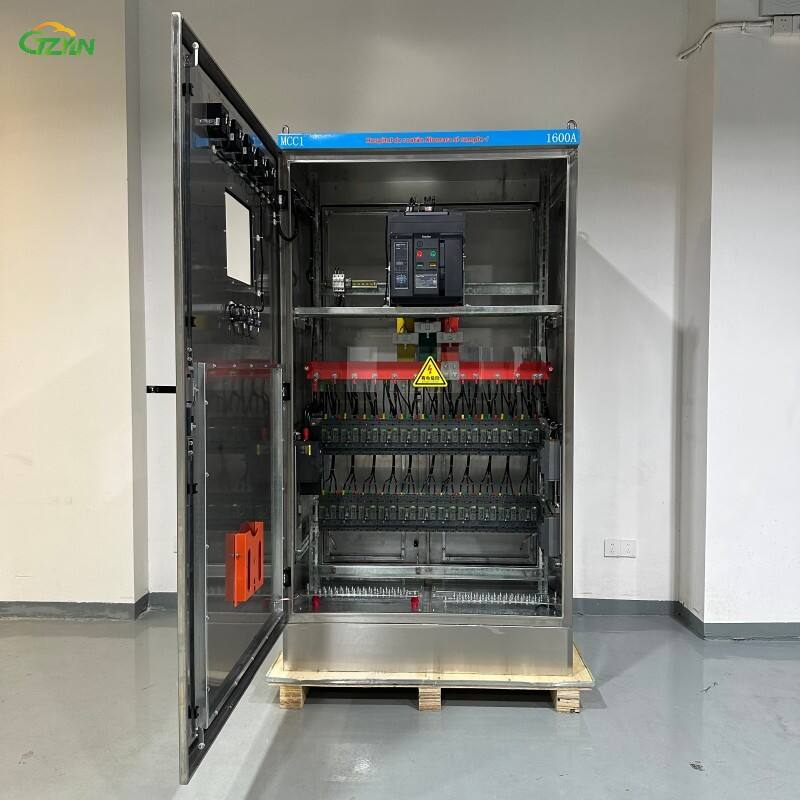Advantages of Busbar Cabinets Over Traditional Power Distribution Systems
Superior Handling of High Amperages
Busbar cabinets handle much higher amperages than traditional power distribution systems, reducing material costs and saving space. Their efficient design lowers the need for bulky cables and complex sub panels. Studies show busbar systems cut heat loss by about 30%, boosting operational efficiency. Electrical engineers at Schneider Electric note these benefits are especially valuable in high-demand areas like data centers and manufacturing plants, where heat management and space are critical.
Flexibility in Configuration Compared to Block-and-Cable Systems
Busbar systems provide greater flexibility due to their modular design, allowing easy reconfiguration as power demands evolve. Unlike traditional block-and-cable systems, busbars reduce installation time and labor costs by up to 40%, according to contractor feedback. This efficiency is especially valuable in projects needing fast deployment and scalability, such as urban infrastructure developments.
Compliance with UL 891 Safety Standards
Compliance with UL 891 safety standards is essential for the safety and reliability of power distribution systems. Busbar cabinets certified to UL 891 show up to a 20% reduction in failure rates. Facility managers and inspectors value the assurance these standards provide, ensuring operational efficiency and occupant safety. This reliability is especially critical in sectors like healthcare and data centers, where continuous power is vital.
Key Features of High-Efficiency Busbar Systems
Copper vs. Aluminum: Material Performance in Power Distribution Boxes
Choosing between copper and aluminum for busbars affects both performance and cost. Copper offers superior conductivity and energy efficiency, reducing transmission losses, but is heavier and more expensive than aluminum. Data show copper busbars have lower energy losses, especially under high loads. Experts also highlight copper’s durability and resistance to environmental factors. Selecting the right material helps businesses improve efficiency and streamline operations.
Laminated Busbars for Enhanced Safety and Heat Dissipation
Laminated busbars stand out for their ability to reduce heat generation and enhance safety in power distribution systems. Structurally designed to minimize electrical resistance, they allow higher load capacities while maintaining a stable temperature, preventing overheating. Data shows laminated busbars offer superior heat dissipation compared to conventional methods, potentially decreasing system stress and improving longevity. Renowned safety organizations endorse laminated designs for their proven reliability and protective benefits. Those aiming to improve system performance while ensuring safety should consider adopting laminated busbars in their sub panel boxes.
Scalability for Evolving Energy Demands
High-efficiency busbar systems excel in scalability, meeting the growing energy demands of modern infrastructure. Their modular design allows easy upgrades and expansions without major disruptions. Industry forecasts emphasize scalable solutions as essential for future-proofing energy distribution. Many facilities have successfully integrated scalable busbar systems, proving their value in dynamic environments. In today’s fast-paced market, scalable power systems offer resilience and adaptability.
Applications in Modern Energy & Power Infrastructure
Integration with EV Charging Stations and Renewable Energy Systems
Busbar systems are becoming an integral component in EV charging infrastructures and renewable energy systems. Their compatibility with these modern applications offers enhanced efficiency gains, making them a robust distribution solution. With the rapid acceleration of electric vehicle (EV) adoption globally and the increased investment in renewable energy, the demand for effective power distribution systems like busbars is growing. For instance, the global electric vehicle market is forecasted to witness significant growth, providing a strong impetus for connected infrastructure and charging solutions. Looking ahead, future advancements in busbar technologies promise to further enhance green power systems, making them even more reliable and efficient for renewable energy objectives.
Role in Smart Grids and Sub Panel Box Configurations
Busbar cabinets are pivotal in the deployment of smart grids and sub panel box configurations, playing a crucial role in modern power infrastructure. They facilitate improved load management and optimal energy distribution, which are essential for smart grid implementations. Case studies have demonstrated how busbar deployments contribute to efficient load balancing, enhancing the overall performance of the grid. Additionally, regulatory requirements around the world are increasingly promoting the integration of smart grid infrastructure. This drives further innovation and adoption of busbar systems in compliance with these standards, ensuring that power distribution networks remain efficient and reliable.
Data Center Power Management Solutions
In data centers, power management is crucial for optimizing performance and ensuring reliability. Busbar systems streamline this process, enhancing power management efficiency and optimizing power usage. Numerous major data centers have successfully adopted busbar technology, reporting measurable enhancements in operational efficiency. For example, centralized power distribution methodologies offered by busbars provide superior reliability, minimizing disruptions and supporting consistent power delivery. As a result, busbar systems are becoming the preferred choice for data center power management solutions, ensuring these facilities can effectively manage their energy demands while maintaining peak performance.
Market Trends Driving Busbar Cabinet Adoption
5.5% CAGR Growth Forecast (2024-2029)
The busbar market is projected to experience a compound annual growth rate (CAGR) of 5.5% from 2024 to 2029, driven by several key factors. Firstly, the increasing demand for efficient power distribution systems in sectors like renewable energy and electric mobility is significantly contributing to this growth. The transition to electric vehicles (EVs), backed by governmental incentives and regulatory pressures, has heightened the need for robust busbar solutions to support enhanced charging infrastructures. According to credible market analysis, innovations in materials, such as the use of copper and aluminum, are optimizing performance and efficiency, further propelling market expansion.
Impact of Smart City Initiatives on Power Distribution Box Demand
Smart city initiatives worldwide are playing a crucial role in driving demand for advanced power distribution systems, including busbar cabinets. Cities like Singapore, Barcelona, and New York have been at the forefront of adopting smart infrastructure technologies that necessitate efficient power distribution solutions. Reports predict a surge in busbar technology adoption as these developments advance, facilitated by features that enhance connectivity and energy efficiency. These growing demands are anticipated to spur enhancements in busbar cabinet features, positioning them as central components in urban energy management systems.
Sustainability Requirements in Commercial & Residential Sectors
The rise in sustainability demands across commercial and residential sectors is leading to increased adoption of energy-efficient power distribution systems, including busbar cabinets. Regulatory pressures aimed at achieving sustainability goals are compelling industries to incorporate eco-friendly technologies. Evidence from case studies shows that busbar cabinets play a significant role in reducing environmental impact by enhancing energy efficiency and minimizing electrical losses. By supporting sustainable practices, busbar cabinets are aligning with ambitious targets aimed at reducing carbon footprints, thereby reinforcing their position as vital components of modern power infrastructures.
Selecting the Optimal Busbar System
Power Rating Considerations: Low/Medium/High Voltage Needs
Selecting the right busbar system requires assessing power ratings for low, medium, and high voltage applications. Each infrastructure has specific demands affecting performance. Calculating power using formulas like helps estimate requirements accurately. Experts advise avoiding mistakes such as underestimating load variations or overlooking environmental factors, which can impact system efficiency. Matching the busbar system to power needs prevents costly issues and ensures reliable operation.
Insulation Type Comparison for Sub Panel Box Installations
Choosing the right insulation for busbar cabinets greatly affects safety and performance. Materials like rigid PVC and flexible rubber each have distinct advantages. Tests show some, such as polyethylene terephthalate (PET), offer superior durability under thermal stress. Environmental factors like humidity and temperature also influence insulation lifespan and efficiency. Proper insulation selection ensures the safety and reliability of busbar systems in varying conditions.
Future-Proofing with Modular Design Capabilities
Modular design capabilities in busbar cabinets allow for easy future expansions and adaptability to evolving power distribution needs. Companies that have successfully implemented modular systems, such as Schneider Electric, have experienced measurable enhancements, like reduced installation time and increased flexibility. When selecting modular busbar designs over conventional setups, it's important to consider factors such as scalability, cost-efficiency, and integration ease with existing systems. These designs not only facilitate current operational needs but also provide a pathway for upgrading systems in response to future technological advancements or increasing infrastructure demands.
FAQ
What are the main advantages of busbar cabinets over traditional systems?
Busbar cabinets offer superior handling of high amperages, reduced material and installation costs, increased space management, and flexibility in configuration, leading to higher efficiency and safety.
Are busbar systems compliant with safety standards?
Yes, busbar cabinets are compliant with UL 891 safety standards, enhancing safety measures and reducing system failure rates crucial for environments requiring reliable power supply.
Can busbar systems be used in modern applications like EV charging or smart grids?
Absolutely, busbar systems integrate seamlessly with EV charging infrastructures and smart grid applications, providing efficient power distribution solutions for modern energy demands.
How do material choices like copper vs. aluminum affect busbar performance?
Copper provides superior conductivity and energy efficiency, though at a higher cost and weight, while aluminum offers lighter, more affordable alternatives with slightly higher energy loss rates.


